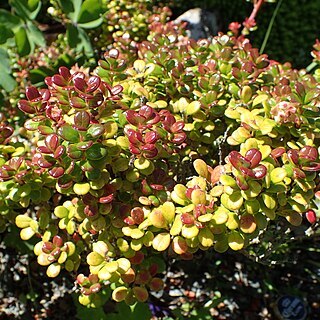Shrubs evergreen, terrestrial or epiphytic, prostrate, or 0.5–1 m tall, many branched; rootstock swollen. Twigs angled, grayish brown pubescent and brown glandular setose; bud scales inconspicuous. Leaves dense; leaf blade obovate, 0.7–1.5 cm × 4–9 mm, leathery, glabrous, secondary veins ca. 3 pairs, inconspicuous abaxially, impressed adaxially, base cuneate, margin plane, cartilaginous, with 1 basal gland per side, sparsely denticulate or subentire, usually sparsely deciduously glandular ciliate, apex rounded, retuse. Inflorescences pseudoterminal, racemose, 1–3 cm, pubescent and glandular setose, 4–8-flowered; bracts caducous, ovate, 5–6 mm. Pedicel 2–4 mm, pubescent and glandular setose. Hypanthium ca. 1 mm, glabrous; calyx limb divided to 1/2; calyx lobes broadly triangular, ca. 0.8 mm, ciliate. Corolla white or pinkish, urceolate, 3–5 mm, glabrous; lobes erect, ca. 0.7 mm. Filaments ca. 1 mm, subglabrous or retrorse-pilose; anthers ca. 2.3 mm, thecae with 2 spreading spurs; tubules ca. as long as thecae. Berry 10-pseudoloculed, dark purple, 4–8 mm in diam. Fl. Mar–May.
More
A compact shrub. It is densely branched and evergreen. It grows 30-90 cm high. Young growth is angled, hairy and is tinged with red. The leaves are rough. They are small and 1.25 cm long by 5 mm wide. They are on short stalks. They have a short sharp point at the tip. The leaves are closely packed on the shoots. The flowers are in groups 1-2 cm long. They hang down and are urn shaped. They are greenish white and can have pink tinges. The fruit is 4 mm across. It is edible. The fruit are blue-purple to black.

